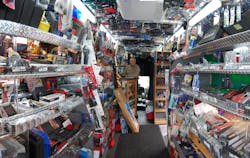As was discussed in my previous column, short repairs are repairs that preventive maintenance (PM) personnel can do in less than 60 minutes with the tools and materials they carry with them.
Such repairs offer a number of benefits. Among them, improvements in:
- A technician’s productivity.
- The reliability of assets.
- The MTBF (mean time before failure).
Have a Conveyance
For the best short repair results, it is necessary to create a PM short repair “cart.”
The size and shape of the cart can vary from a rolling cart or toolbox, to a mini-shop within a truck or trailer. Each should be customized to the fleet’s/shop’s needs and requirements because each kind of asset group might need additional small parts, specialized tools, lubricants, cleaning tools, etc.
Here are some recommendations for designing your PM short repair cart:
- Determine the must-have items for the cart.
- Each cart should have a cart inventory list and always should carry these items.
- The last daily task is to replenish the items on the cart and to clean it.
- Study corrective work orders and add items to the cart based on the repairs.
- Periodically meet with the PM crews and discuss completed jobs and those that could not be completed because the tools and materials needed were not readily available. Adjust the cart inventory list based on these discussions.
- Allow individual PM personnel to add things to the cart. At the periodic meetings, discuss the individual additions to see if they warrant being added to the cart inventory list on a permanent basis.
The overall objective in designing your particular cart is to maximize short repair opportunities.
Discipline
The key to PM short repair carts is discipline. It is important that the tools and unused materials are put into their designated storage locations on the cart after each use.
Furthermore, clean, lubricate, charge batteries, etc., on all tools and equipment on the cart the end of every PM day. There is nothing more frustrating than being in the middle of a short repair and having a dead battery on a needed screw gun or drill.
Explore
Tremendous thought goes into how a service person outfits his service vehicle. The next time you have an opportunity, ask the tool truck person, telephone installer, lift truck repair person, etc., to see how their truck is set up and why. This will provide you with some good ideas and insight that you can use to better outfit your PM short repair cart.
The more often a PM technician has the required tool or part on hand to do a short repair, the less time is wasted searching for them, which diminishes “wrench time.” Additional wrench time translates into improved technician and shop productivity.
Joel Levitt is director of international projects for Life Cycle Engineering (www.lce.com), an organization that provides consulting, engineering, applied technology and education solutions that deliver lasting results. Previously, he was president of Springfield Resources (www.maintenancetraining.com), a management consulting firm.
About the Author

Joel Levitt
President, Springfield Resources
Joel Levitt has trained more than 17,000 maintenance leaders from more than 3,000 organizations in 24 countries. He is the president of Springfield Resources, a management consulting firm that services a variety of clients on a wide range of maintenance issues www.maintenancetraining.com. He is also the designer of Laser-Focused Training, a flexible training program that provides specific targeted training on your schedule, online to one to 250 people in maintenance management, asset management and reliability.
